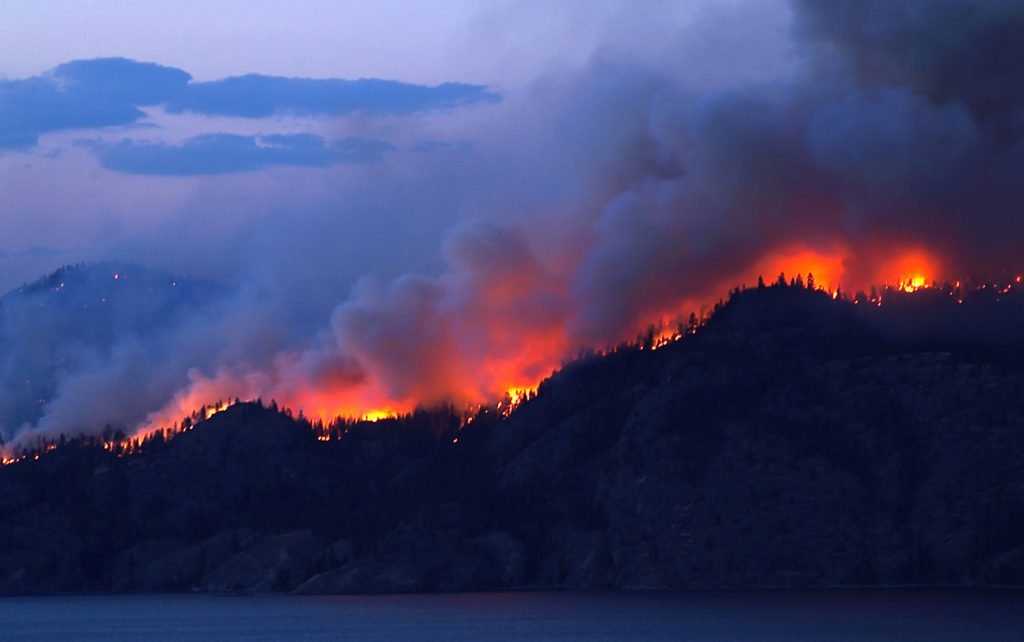A wildfire is considered any unwanted or unplanned fire burning in forest, shrub, or grass. Wildfires are one of the most destructive natural disasters that exist and occur year-round all over the world. Some of the most common areas susceptible to wildfires are as follows:
- Western US: August – December
- Southeastern US: October – December
- Western Canada: April – September
- Southeastern Australia: December – March
- Northern Australia: April – September
- Russia: May – October
- South America (Amazon rainforest and the Cerrado): May – September
Although they can be caused naturally due to lightning strikes, the majority of wildfires – estimated to be around 90 percent – are caused by humans. Examples of these human-caused wildfires include unattended campfires, sparks from vehicles or equipment, or arson.
Wildfire Severity Factors
Changes in climate will likely alter wildfire frequency and severity in the future. Climate models predict longer periods of drought and higher temperatures, which would increase wildfire frequency, especially in semi-arid portions of the globe. Additionally, tropical areas are projected to experience higher rainfall totals due to changes in climate, which would decrease the frequency of wildfires. However, the abundant vegetation growth as a result of increased rainfall could result in more severe wildfires, if they are able to ignite, due to the increased source of fuel. The three major factors that determine the severity of a wildfire include weather, topography, and fuel sources.
- Weather: The likelihood of a major wildfire increases with dry, hot, and windy conditions. This type of weather makes fire ignition easier, allows fuel to burn more rapidly, and increases fire intensity. For example, higher wind speeds can transform a small, manageable fire into an uncontained catastrophic event in very little time.
- Topography: Slope steepness also influences the behavior of a wildfire. The more steeply sloped the terrain, the more increased the rate at which the fire spreads. Additionally, uneven and steep terrain make containment efforts more difficult for responding authorities. Other topographic features that influence wildfire severity include the direction a slope faces (south- and southwest-facing slopes are most favorable for fires) and narrow drainages (can act as chimneys). The loss of vegetation due to wildfires can cause further problems due to an increased threat of flash flooding and mudflows.
- Fuel Sources: Wildfires are mainly fueled by living vegetation and dead plant matter. However, houses and other structures may also become a source of fuel.
Wildfire Hazards
Wildfires can have negative health consequences that extend beyond extinguishing the fire. Smoke associated with wildfires is a mixture of gases and fine particles from burning trees, plants, and sometimes building materials, which can pose major health concerns. Such smoke can hurt the eyes, irritate the respiratory system, and may worsen symptoms for people who have pre-existing respiratory conditions – such as respiratory allergies, asthma, or chronic obstructive pulmonary disease (COPD). Smoke from wildfires poses health concerns not only for people in the immediate area, but also those in areas downwind of the wildfire. Learn more about the health effects from wildfire smoke exposure.
Mitigating Wildfire Risk During a Trip
When planning an outdoor trip, develop a safety plan. Be sure you are traveling to a safe environment and are prepared with the equipment to keep the area free of accidental wildfires. Examples of necessary equipment include a bucket of water and a shovel to douse the flames and cover the remaining embers of the campfire to make sure the fire is extinguished completely. Additionally, make sure to have a plan, including an emergency supply kit, in case you are threatened by a wildfire.
Take these steps as part of your wildfire safety plan:
- Know the area you are staying in. If camping, make sure to plan two possible escape routes should you need to evacuate the area and if one route is blocked due to the fire.
- Create a checklist of gear, rules and reminders, including packing necessary fire-prevention items, clearing the area of nearby brush before lighting your campfire, and having a full tank of gas if evacuation is necessary.
- Be prepared to use proper campfire extinguishing techniques. Adhering to a few simple rules and reminders can help keep outdoor parks and woodland areas safe.
- Pay attention if there are any fire or travel restrictions in effect in the area to which you are traveling. Call local fire departments, forest service, or government representatives to ensure an area is restriction-free.
- Be aware of the weather forecast. If you are traveling during fire season, avoid areas that could experience potentially dangerous weather patterns, including excessive heat, low humidity, and strong winds.
At the first sign of a wildfire or notification of a mandatory evacuation, leave the area immediately using established trails or roadways. Contact fire officials as soon as possible. If an escape route is blocked, go to the nearest lake or stream and stay in the water while the fire passes overhead or is stopped due to the water barrier. Be sure to contact local authorities using a mobile phone or radio to notify them of your current location and situation.
About WorldAware
WorldAware provides intelligence-driven, integrated risk management solutions that enable multinational organizations to operate globally with confidence. WorldAware’s end-to-end tailored solutions integrated world-class threat intelligence, innovative technology, and response services to help organizations mitigate risk and protect their employees, assets, and reputation.

